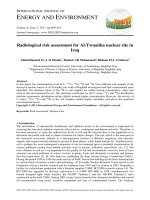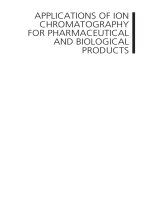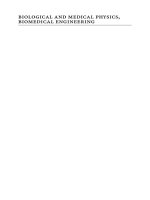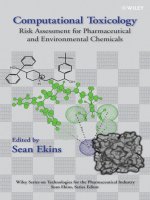computational toxicology - risk assessment for pharmaceutical and environmental chemicals - s. ekins (wiley, 2007)
Bạn đang xem bản rút gọn của tài liệu. Xem và tải ngay bản đầy đủ của tài liệu tại đây (17.9 MB, 854 trang )
COMPUTATIONAL TOXICOLOGY
COMPUTATIONAL
TOXICOLOGY
Risk Assessment for Pharmaceutical
and Environmental Chemicals
Edited by
SEAN EKINS
WILEY-INTERSCIENCE
A JOHN WILEY & SONS, INC., PUBLICATION
Cover design/concept by Sean Ekins using images from Chapters 13, 16, and 19.
Copyright © 2007 by John Wiley & Sons, Inc. All rights reserved
Published by John Wiley & Sons, Inc., Hoboken, New Jersey
Published simultaneously in Canada
No part of this publicatin may be reproduced, stored in a retrieval system, or transmitted in
any form or by any means, electronic, mechanical, photocopying, recording, scanning, or
otherwise, except as permitted under Section 107 or 108 of the 1976 United States Copyright
Act, without either the prior written permission of the Publisher, or authorization through
payment of the appropriate per-copy fee to the Copyright Clearance Center, Inc., 222
Rosewood Drive, Danvers, MA 01923, (978) 750-8400, fax (978) 750-4470, or on the web at
www.copyright.com. Requests to the Publisher for permission should be addressed to the
Permissions Department, John Wiley & Sons, Inc., 111 River Street, Hoboken, NJ 07030, (201)
748-6011, fax (201) 748-6008, or online at />Limit of Liability/Disclaimer of Warranty: While the publisher and author have used their best
efforts in preparing this book, they make no representations or warranties with respect to the
accuracy or completeness of the contents of this book and specifically disclaim any implied
warranties of merchantability or fitness for a particular purpose. No warranty may be created
or extended by sales representatives or written sales materials. The advice and strategies
contained herein may not be suitable for your situation. You should consult with a professional
where appropriate. Neither the publisher nor author shall be liable for any loss of profit or any
other commercial damages, including but not limited to special, incidental, consequential, or
other damages.
For general information on our other products and services or for technical support, please
contact our Customer Care Department within the United States at (800) 762-2974, outside the
United States at (317) 572-3993 or fax (317) 572-4002.
Wiley also publishes its books in a variety of electronic formats. Some content that appears in
print may not be available in electronic formats. For more information about Wiley products,
visit our web site at www.wiley.com.
Wiley Bicentennial logo: Richard J. Pacifico
Library of Congress Cataloging-in-Publication Data:
Computational toxicology : risk assessment for pharmaceutical and environmental chemicals /
edited by Sean Ekins.
p. ; cm. – (Wiley series on technologies for the pharmaceutical industry)
Includes bibliographical references and index.
ISBN 978-0-470-04962-4 (cloth)
1. Toxicology – Mathematical models. 2. Toxicology – Computer simulation. 3. QSAR
(Biochemistry) I. Ekins, Sean. II. Series.
[DNLM: 1. Toxicology – methods. 2. Computer Simulation. 3. Drug Toxicity.
4. Environmental Pollutants – toxicity. 5. Risk Assessment. QV 602 C738 2007]
RA1199.4.M37C66 2007
615.9001′5118–dc22
2006100242
Printed in the United States of America
10 9 8 7 6 5 4 3 2 1
To Maggie
It is very evident, that all other methods of improving medicine have been found
ineffectual, by the stand it has been at these two or three thousand years; and
that since of late mathematicians have set themselves to the study of it, men
do already begin to talk intelligibly and comprehensibly, even about abstruse
matters, that it may be hop’d in a short time, if those who are designed for this
profession are early, while their minds and bodies are patient of labour and toil,
initiated in the knowledge of numbers and geometry, that mathematical learning
will be the distinguishing mark of a physician from a quack: and that he who
wants this necessary qualification, will be as ridiculous as one without Greek or
Latin.
Richard Mead
A mechanical account of poisons in several essays
2nd edition, London, 1708.
CONTENTS
SERIES INTRODUCTION
PREFACE
xiii
ACKNOWLEDGMENTS
CONTRIBUTORS
PART I
1
xi
INTRODUCTION TO TOXICOLOGY METHODS
An Introduction to Toxicology and Its Methodologies
xv
xvii
1
3
Alan B. Combs and Daniel Acosta Jr.
2
In vitro Toxicology: Bringing the In silico and In vivo
Worlds Closer
21
Jinghai J. Xu
3
Physiologically Based Pharmacokinetic and Pharmacodynamic
Modeling
33
Brad Reisfeld, Arthur N. Mayeno, Michael A. Lyons,
and Raymond S. H. Yang
4
Species Differences in Receptor-Mediated Gene Regulation
71
Edward L. LeCluyse and J. Craig Rowlands
5
Toxicogenomics and Systems Toxicology
99
Michael D. Waters, Jennifer M. Fostel, Barbara A. Wetmore,
and B. Alex Merrick
vii
viii
CONTENTS
PART II
6
COMPUTATIONAL METHODS
Toxicoinformatics: An Introduction
151
153
William J. Welsh, Weida Tong, and Panos G. Georgopoulos
7
Computational Approaches for Assessment of Toxicity:
A Historical Perspective and Current Status
183
Vijay K. Gombar, Brian E. Mattioni, Craig Zwickl, and J. Thom Deahl
8
Current QSAR Techniques for Toxicology
217
Yu Zong Chen, Chun Wei Yap, and Hu Li
PART III
9
APPLYING COMPUTERS TO TOXICOLOGY
ASSESSMENT: PHARMACEUTICAL
The Prediction of Physicochemical Properties
239
241
Igor V. Tetko
10
Applications of QSAR to Enzymes Involved in Toxicology
277
Sean Ekins
11
QSAR Studies on Drug Transporters Involved in Toxicology
295
Gerhard F. Ecker and Peter Chiba
12
Computational Modeling of Receptor-Mediated Toxicity
315
Markus A. Lill and Angelo Vedani
13
Applications of QSAR Methods to Ion Channels
353
Alex M. Aronov, Konstantin V. Balakin, Alex Kiselyov,
Shikha Varma-O’Brien, and Sean Ekins
14
Predictive Mutagenicity Computer Models
391
Laura L. Custer, Constantine Kreatsoulas, and Stephen K. Durham
15
Novel Applications of Kernel–Partial Least Squares to
Modeling a Comprehensive Array of Properties for
Drug Discovery
403
Sean Ekins, Mark J. Embrechts, Curt M. Breneman, Kam Jim,
and Jean-Pierre Wery
16
Homology Models Applied to Toxicology
433
Stewart B. Kirton, Phillip J. Stansfeld, John S. Mitcheson,
and Michael J. Sutcliffe
17
Crystal Structures of Toxicology Targets
469
Frank E. Blaney and Ben G. Tehan
18
Expert Systems
Philip N. Judson
521
ix
CONTENTS
19
Strategies for Using Computational Toxicology Methods in
Pharmaceutical R&D
545
Lutz Müller, Alexander Breidenbach, Christoph Funk,
Wolfgang Muster, and Axel Pähler
20
Application of Interpretable Models to ADME/TOX Problems
581
Tomoko Niwa and Katsumi Yoshida
PART IV
21
APPLYING COMPUTERS TO TOXICOLOGY
ASSESSMENT: ENVIRONMENTAL
The Toxicity and Risk of Chemical Mixtures
599
601
John C. Lipscomb, Jason C. Lambert, and Moiz Mumtaz
22
Environmental and Ecological Toxicology: Computational
Risk Assessment
625
Emilio Benfenati, Giovanna Azimonti, Domenica Auteri,
and Marco Lodi
23
Application of QSARs in Aquatic Toxicology
651
James Devillers
24
Dermatotoxicology: Computational Risk Assessment
677
Jim E. Riviere
PART V
25
NEW TECHNOLOGIES FOR TOXICOLOGY:
FUTURE AND REGULATORY PERSPECTIVES
Novel Cell Culture Systems: Nano and Microtechnology for
Toxicology
693
695
Mike L. Shuler and Hui Xu
26
Future of Computational Toxicology: Broad Application into
Human Disease and Therapeutics
725
Dale E. Johnson, Amie D. Rodgers, and Sucha Sudarsanam
27
Computational Tools for Regulatory Needs
751
Arianna Bassan and Andrew P. Worth
INDEX
777
SERIES INTRODUCTION
This book is the first in a series to be published by Wiley entitled Technologies
for the Pharmaceutical Industry. The series aims to bring opinion leaders
together to address important topics for the industry, from their implementation of technologies to current challenges. The pharmaceutical industry is at
a critical juncture. It is pressured by patients on one side wanting effective
treatments for diseases and governments trying to curtail health care spending
while on the other side limited patent life and competition from generics all
compound the issue. New technologies are one of the keys to maintaining
competitiveness and minimizing the time for an idea coming from the bench
to the bedside. Importantly these volumes will also describe how key technologies are likely to impact the direction in discovery and development for the
future and will be accessible to readers both inside and outside the industry.
Significant emphasis will also be put on the application rather than theory
presented from both industrial and academic perspectives. At the time of
going to press, two books are in preparation on in vitro–in vivo correlations,
and biomarkers, with others in the pipeline. To ensure that the topics published are timely and relevant, an editorial board has been established and is
listed in the front of this book. I gratefully acknowledge this team of scientists
and those preparing the first volumes in the series for their time and willingness to assist me in this endeavor as we begin the series here.
xi
PREFACE
It would have been unusual to mention the importance of mathematics to
physicians in a book on poisons in the eighteenth century (Richard Mead, A
mechanical account of poisons in several essays, second edition published in
1708), but nearly 300 years later mathematical and computational (in silico)
methods are valuable assets for toxicology as they are in many other areas of
science. From such a vantage point no one would have foreseen the broad
impact and importance of toxicology itself, let alone its entwined relationship
with pharmaceutical and environmental research. Now is the time for an
assessment of the convergence of toxicology and computational methods in
these areas and to outline where they will go in the future.
In pharmaceutical drug discovery and development, processes are in constant flux as new technologies are continually devised, tested, validated, and
implemented. However, we have seen in the recent white paper from the US
FDA on innovation stagnation in toxicology, that this is not always the case.
Areas key to the overall development continue to use old technologies and
processes and are not keeping pace with other developments in disparate fields
of pharmaceutical research. This may be just the tip of the iceberg. If this
industry is to improve its ability to rapidly identify and test therapeutics clinically with a high probability of success, it needs to discover and embrace new
technologies early on.
Currently many companies, academics, regulatory authorities, and global
organizations have or are evaluating the use of new predictive tools to improve
human hazard assessment, (drug toxicity, P450 mediated drug metabolism
etc.). For example the interaction of molecules can be predicted by using
computer-based tools utilizing X-ray crystal structures, homology, receptor,
pharmacophore, and QSAR models of human enzymes, transporters, nuclear
xiii
xiv
PREFACE
receptors, ion channels, as well as other physicochemical properties and
complex endpoints. In silico modeling for toxicology may therefore provide
effective pre-screening for chemicals in pharmaceutical discovery and the
chemical industry in general, and their effects on the environment may also
be predicted. The criteria for the validation of computational toxicology
models and other requirements for regulatory acceptance have not yet been
widely discussed. This book addresses all of the above-mentioned areas and
many more, presenting computational toxicology from an international and
holistic perspective that differs significantly from recently published papers
and books in the computational toxicology field.
The book is split into five key sections:
I.
II.
III.
IV.
V.
Introduction to Toxicology Methods
Computational Methods
Applying Computers to Toxicology Assessment: Pharmaceutical
Applying Computers to Toxicology Assessment: Environmental
New Technologies for Toxicology: Future and Regulatory Perspectives
The book includes a comprehensive discussion on the state of the art of currently available molecular-modeling software for toxicology and their role in
testing strategies for different types of toxicity when used alongside in vitro and
in vivo models. The publication of this book comes at a critical time as we are
now seeing REACH legislation coming into effect whose goal is to increase the
amount of toxicological data required on tens of thousands of manufactured
chemicals in order to predict the effect of chemicals on human health and their
environmental impact. Naturally there has to be some means to prioritize in
vitro and in vivo testing, and computational toxicology will be critical. The role
of these computational approaches in addressing environmental and occupational toxicity is therefore covered broadly in this book, as well as new technologies and thoughts on the past, present, and future of computational toxicology
and its applicability to chemical design. Each chapter is written by one or more
leading expert in the field from industry, academe, or regulatory authorities,
and each chapter has been edited to ensure consistency. Extensive use of
explanatory figures is made, and all chapters include extensive key references
for readers to delve deeper into topics at their own leisure.
This book is not aimed solely at laboratory toxicologists, as scientists of all
disciplines in the pharmaceutical, chemical industries, and environmental sciences will find it of value. In particular, those researchers involved in ADMET,
drug discovery, systems biology, and software development should benefit
greatly from reading this book. The accessibility to the general reader with
some scientific background should enable this volume to serve as an educational tool that inspires readers to pursue further the technologies presented.
I hope you enjoy this book and benefit from the insights offered by the variety
of contributing authors, as we take you on a tour of computational toxicology
and go beyond—in silico.
ACKNOWLEDGMENTS
I am extremely grateful to Jonathan Rose at John Wiley who initiated this
project and provided considerable assistance for initial chapter ideas and
author suggestions. Thank you for getting me involved and allowing me to
edit it. In addition I would like to thank all the team at Wiley for their assistance and in particular, Danielle Lacourciere for patiently putting the book
together. My anonymous proposal reviewers are kindly acknowledged for
their helpful suggestions, and along with other scientists who provided numerous ideas for additional authors, they greatly helped bring the book closer to
its final format. Thank you!
I am immensely grateful to the many outstanding authors of the chapters
for agreeing to contribute their valuable time, sharing their latest work and
ideas, while patiently putting up with my editorial changes. This book represents their considerable talents. Although we have referenced many groups in
these chapters, I acknowledge the many others that may have been omitted
due to lack of space.
I would also like to take this opportunity to thank The Othmer Library at
the Chemical Heritage Foundation in Philadelphia and, in particular, Ms.
Ashley Augustyniak, Assistant Librarian, for providing access to a copy of the
historic Mead text.
My studies in computational toxicology owe a great deal to collaboration
with colleagues in both industry and academia, and several of these are contributors here. I acknowledge them all for letting me participate in stimulating
science with them.
My parents and family have been incredibly supportive over what has been
a tumultuous year. I dedicate this book to all my family in the United Kingdom
xv
xvi
ACKNOWLEDGMENTS
and the United States, and to Maggie, in particular, for her continued steadfast
support, valuable advice, and general encouragement to continue in the face
of all adversity, this is for you.
Sean Ekins
Jenkintown, Pennsylvania
September 2006
CONTRIBUTORS
Daniel Acosta Jr., College of Pharmacy, University of Cincinnati, 3225 Eden
Avenue, Cincinnati, OH 45267, USA. ()
Alex M. Aronov, Vertex Pharmaceuticals Inc., 130 Waverly Street, Cambridge, MA 02139-4242, USA. ()
Domenica Auteri, International Centre for Pesticides and Health Risk Prevention, Milano, Italy.
Giovanna Azimonti, International Centre for Pesticides and Health Risk
Prevention, Milano, Italy.
Konstantin V. Balakin, ChemDiv, Inc. 11558 Sorrento Valley Road, Suite 5,
San Diego, CA 92121, USA. ()
Arianna Bassan, European Chemicals Bureau, Joint Research Centre, European Commission, Ispra, 21020 (VA), Italy.
Emilio Benfenati, Laboratory of Environmental Chemistry and Toxicology, Istituto di Ricerche Farmacologiche “Mario Negri,” Milano, Italy.
()
Frank E. Blaney, Computational, Analytical and Structural Sciences, GlaxoSmithKline Medicines Research, NFSP (North), Third Avenue, Harlow,
Essex CM19 5AW, UK. ()
Alexander Breidenbach, Hoffmann-La Roche, PRBN-T, Bldg. 73/311B,
CH-4070, Basel, Switzerland.
xvii
xviii
CONTRIBUTORS
Curt M. Breneman, Department of Chemistry, Rensselaer Polytechnic Institute, 110 Eighth Street, Troy, NY 12180, USA.
Yu Zong Chen, Bioinformatics and Drug Design Group, Department of
Computational Science, National University of Singapore, Blk SOC1, Level
7, 3 Science Drive 2, Singapore 117543. ()
Peter Chiba, Institute of Medical Chemistry, Medical University Vienna,
Waehringerstrasse 10, A-1090 Wien, Austria.
Alan B. Combs, College of Pharmacy, 2409 University Avenue, A2925 Austin,
TX 78712, USA. ()
Laura L. Custer, Drug Safety Evaluation, Bristol-Myers Squibb Pharmaceutical Research Institute, Syracuse, NY, USA. ()
J. Thom Deahl, Lilly Research Laboratories, Division of Eli Lilly and
Company, Toxicology and Drug Disposition, Greenfield, IN 46140, USA.
James Devillers, CTIS, 3 Chemin de la Gravière, 69140 Rillieux La Pape,
France. ()
Stephen K. Durham, Charles River Laboratories, 587 Dunn Circle, Sparks,
NV 89431, USA. ()
Gerhard F. Ecker, Emerging Field Pharmacoinformatics, Department of
Medicinal Chemistry, University of Vienna, Althanstraße 14, A-1090 Wien,
Austria. ()
Sean Ekins, ACT LLC, 1 Penn Plaza–36th Floor, New York, NY 10119, USA.
()
Mark J. Embrechts, Department of Decision Sciences and Engineering
Systems, Rensselaer Polytechnic Institute, CII 5217, Troy, NY 12180, USA.
()
Jennifer M. Fostel, National Center for Toxicogenomics, National Institute
of Environmental Health Sciences, PO Box 12233, MD F1-05, 111 Alexander Drive Research Triangle Park, NC 27709-2233, USA.
Christoph Funk, Hoffmann-La Roche, PRBN-T, Bldg. 73/311B, CH-4070,
Basel, Switzerland.
Panos G. Georgopoulos, Department of Environmental and Occupational
Medicine & Environmental and Occupational Health Sciences Institute,
UMDNJ-RWJMS and Rutgers, the State University of New Jersey & Environmental Bioinformatics and Computational Toxicology Center (ebCTC),
Piscataway, NJ 08854, USA.
Vijay K. Gombar, Lilly Research Laboratories, Division of Eli Lilly
and Company, Lilly Corporate Center, Indianapolis, IN 46285, USA.
()
CONTRIBUTORS
xix
Kam Jim, 5 Donald Avenue, Kendall Park, NJ 08824, USA. (kamcjim@gmail.
com)
Dale E. Johnson, Emiliem, Inc., 6027 Christie Avenue, Emeryville, CA 94608,
USA. ()
Philip N. Judson, Judson Consulting Service, Heather Lea, Bland Hill,
Norwood, Harrogate HG3 1TE, UK. ()
Stewart B. Kirton, NCE Discovery Ltd, 418 Science Park, Cambridge, CB24
0PZ, UK.
Alex Kiselyov, ChemDiv, Inc. 11558 Sorrento Valley Road, Suite 5, San
Diego, CA 92121, USA.
Constantine Kreatsoulas, Merck Research Laboratories, Merck and Co. Inc.,
Rahway, NJ, USA.
Jason C. Lambert, Oak Ridge Institute for Science and Education, On assignment to the US Environmental Protection Agency, Cincinnati, OH, USA.
Edward L. LeCluyse, CellzDirect, 480 Hillsboro Street, Suite 130 Pittsboro,
NC 27312, USA. ()
Hu Li, Bioinformatics and Drug Design Group, Department of Computational Science, National University of Singapore, Blk SOC1, Level 7, 3
Science Drive 2, Singapore 117543.
Markus A. Lill, Institute of Molecular Pharmacy, Pharmacenter, University of Basel, Klingelbergstrasse 50, 4056 Basel, Switzerland and Biographics Laboratory 3R, Friendensgasse 35, 4056 Basel, Switzerland.
()
John C. Lipscomb, US Environmental Protection Agency, National Center
for Environmental Assessment, 26 West Martin Luther King Drive
(MS-190), Cincinnati, OH 45268, USA. ()
Marco Lodi, Laboratory of Environmental Chemistry and Toxicology, Istituto di Ricerche Farmacologiche “Mario Negri,” Milano, Italy.
Michael A. Lyons, Department of Environmental and Radiological Health
Sciences Colorado State University, 1681 Campus Delivery, Fort Collins,
CO 80523-1681, USA ()
Brian E. Mattioni, Lilly Research Laboratories, Division of Eli Lilly and
Company, Lilly Corporate Center, Indianapolis, IN 46285, USA.
Arthur N. Mayeno, Department of Environmental and Radiological Health
Sciences Colorado State University, 1681 Campus Delivery, Fort Collins,
CO 80523-1681, USA. ()
xx
CONTRIBUTORS
B. Alex Merrick, National Center for Toxicogenomics, National Institute of
Environmental Health Sciences, PO Box 12233, MD F1-05, 111 Alexander
Drive Research Triangle Park, NC 27709-2233, USA.
John S. Mitcheson, Department of Cell Physiology and Pharmacology, University of Leicester, University Road, Leicester, LE1 7RH, UK.
Lutz Müller, Hoffmann-La Roche, PRBN-T, Bldg. 73/311B, CH-4070, Basel,
Switzerland. ()
Moiz Mumtaz, Agency for Toxic Substances and Disease Registry, Atlanta,
GA, USA.
Wolfgang Muster, Hoffmann-La Roche, PRBN-T, Bldg. 73/311B, CH-4070,
Basel, Switzerland.
Tomoko Niwa, Discovery Research Laboratories, Nippon Shinyaku Co., Ltd.
14, Nishinosho-Monguchi-cho, Kisshoin, Minami-ku Kyoto, 601-8550,
Japan. ()
Axel Pähler, Hoffmann-La Roche, PRBN-T, Bldg. 73/311B, CH-4070, Basel,
Switzerland.
Brad Reisfeld, Department of Chemical and Biological Engineering and
Department of Environmental and Radiological Health Sciences, Colorado
State University, 1370, Campus Delivery, Fort Collins, CO 80523-1370,
USA. ()
Jim E. Riviere, Center for Chemical Toxicology Research and Pharmacokinetics Biomathematics Program, Carolina State University, Raleigh, NC,
USA. ()
Amie D. Rodgers, Emiliem, Inc., 6027 Christie Avenue, Emeryville, CA
94608, USA.
J. Craig Rowlands, The Dow Chemical Company, Toxicology and Environmental Research and Consulting, 1803 Building, Midland, MI 48674, USA.
()
Mike L. Shuler, Department of Biomedical Engineering, Cornell University,
Ithaca, NY, USA. ()
Phillip J. Stansfeld, Department of Cell Physiology and Pharmacology, University of Leicester, University Road, Leicester, LE1 7RH, UK.
Sucha Sudarsanam, Emiliem, Inc., 6027 Christie Ave, Emeryville, CA 94608,
USA.
Michael J. Sutcliffe, Manchester Interdisciplinary Biocentre & School of
Chemical Engineering and Analytical Science, University of Manchester,
131 Princess Street, Manchester, M1 7ND, UK. (michael.sutcliffe@
manchester.ac.uk)
CONTRIBUTORS
xxi
Ben G. Tehan, Computational, Analytical and Structural Sciences, GlaxoSmithKline Medicines Research, NFSP (North), Third Avenue, Harlow,
Essex CM19 5AW, UK.
Igor V. Tetko, Institute for Bioinformatics, GSF–National Research Centre
for Environment and Health, Ingolstädter Landstraße 1, D-85764 Neuherberg, Germany. ()
Weida Tong, Center for Toxicoinformatics, US Food and Drug Administration–National Center for Toxicological Research (US FDA-NCTR),
Jefferson, AR 72079, USA.
Shikha Varma-O’Brien, Accelrys, Inc., 10188 Telesis Court, Suite 100, San
Diego CA, 92121, USA.
Angelo Vedani, Institute of Molecular Pharmacy, Pharmacenter, University
of Basel, Klingelbergstrasse 50, 4056 Basel, Switzerland and Biographics
Laboratory 3R, Friendensgasse 35, 4056 Basel, Switzerland. (angelo@
biograf.ch)
Michael D. Waters, Integrated Laboratory Systems, Inc., PO Box 13501,
Research Triangle Park, NC 27709, USA. ()
William J. Welsh, Department of Pharmacology, University of Medicine &
Dentistry of New Jersey-Robert Wood Johnson Medical School (UMDNJRWJMS) & Environmental Bioinformatics and Computational Toxicology
Center (ebCTC) & the Informatics Institute of UMDNJ, Piscataway, NJ
08854, USA. ()
Jean-Pierre Wery, INCAPS, 351 West 10th Street, Suite 350, Indianapolis,
IN 46202, USA. ()
Barbara A. Wetmore, National Center for Toxicogenomics, National Institute of Environmental Health Sciences, PO Box 12233, MD F1-05, 111
Alexander Drive Research Triangle Park, NC 27709-2233, USA.
Andrew P. Worth, European Chemicals Bureau, Joint Research Centre,
European Commission, Ispra, 21020 (VA), Italy. ()
Hui Xu, Department of Biomedical Engineering, Cornell University, Ithaca,
NY, USA. ()
Jinghai J. Xu, Pfizer Inc., Research Technology Center, 620 Memorial Drive,
Rm. 367, Cambridge, MA 02139, USA. (jim.xu@pfizer.com)
Raymond S. H. Yang, Department of Environmental and Radiological Health
Sciences, Colorado State University, 1681 Campus Delivery, Fort Collins,
CO 80523-1681, USA. ()
xxii
CONTRIBUTORS
Chun Wei Yap, Bioinformatics and Drug Design Group, Department of
Computational Science, National University of Singapore, Blk SOC1, Level
7, 3 Science Drive 2, Singapore 117543.
Katsumi Yoshida, Discovery Research Laboratories, Nippon Shinyaku Co.,
Ltd. 14, Nishinosho-Monguchi-cho, Kisshoin, Minami-ku Kyoto, 601-8550,
Japan.
Craig Zwickl, Lilly Research Laboratories, Division of Eli Lilly and Company,
Toxicology and Drug Disposition, Greenfield, IN 46140, USA.
PART I
INTRODUCTION TO TOXICOLOGY
METHODS









